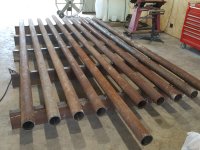joeu235
Platinum Member
- Joined
- Mar 27, 2014
- Messages
- 724
- Location
- Little River, TX
- Tractor
- John Deere 4020 / 6403 / 317 Ford 5600
Its 95 and still the month of May.  I'm stick welding and sweating my butt off. I've got a big shop fan going. Is there a wind velocity that can blow the shielding off a stick weld?
I'm stick welding and sweating my butt off. I've got a big shop fan going. Is there a wind velocity that can blow the shielding off a stick weld?

